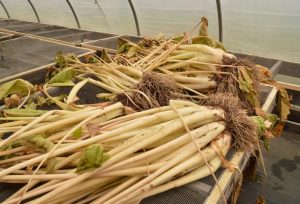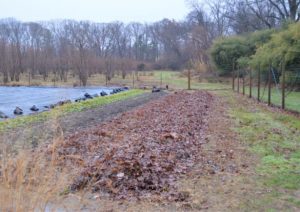October marks the true start of autumn and much work for the gardener! We are now racing against time to complete our chores before that first strong frost. September was a fairly dry month, so watering chores are certainly high on the list! Always remember to take a moment and make some notes about your garden. Among other details, take note of what annuals are still looking respectable, which late season vegetables are living up to expectations, and perhaps what woody plants or perennials should be added to enhance the autumn garden for next year!
Things to do:
- Finish ordering and start planting spring flowering bulbs.
 Prepare tuberous rooted plants for winter. Those such as Elephant Ears (Alocasia and Colocasia), Dahlia, Canna, and Banana (Musa and Ensete), which have a storage-type of root system can be dug, allowed to dry (as seen at right), cut back, wrapped in newspaper, and stored in a cool (50-55°F), dry basement. They can also be potted into a container and kept on the drier side throughout the winter.
Prepare tuberous rooted plants for winter. Those such as Elephant Ears (Alocasia and Colocasia), Dahlia, Canna, and Banana (Musa and Ensete), which have a storage-type of root system can be dug, allowed to dry (as seen at right), cut back, wrapped in newspaper, and stored in a cool (50-55°F), dry basement. They can also be potted into a container and kept on the drier side throughout the winter.- October is likely to be the last chance to take and root cuttings of tender plants, such as Spurflower (Plectranthus), Coleus, and Geraniums. Other plants that are not of hybrid origin can be overwintered by collecting the seed and stored in the lettuce draw of the refrigerator. Various species of Solanum, Asclepias, Nicotiana and Amaranthus are ideal for overwintering in this manner. Remember, the average frost date is October 15th, although frosts appear to be coming later and we may not receive a killing frost until early November.
 Time to take care of your containers. Bring in, empty and clean any valuable containers to prevent damage from freeze-thaw cycles of winter. Wash clay containers inside and out to remove salts from fertilizers. For plastic and other weather resistant containers, add annuals that are more tolerant of frost for autumn color, such as Chrysanthemums, Ornamental Cabbage, Kale or even Red Stemmed Willows (Salix alba ‘Britzensis’), which can remain and provide color throughout the winter (pictured at right)!
Time to take care of your containers. Bring in, empty and clean any valuable containers to prevent damage from freeze-thaw cycles of winter. Wash clay containers inside and out to remove salts from fertilizers. For plastic and other weather resistant containers, add annuals that are more tolerant of frost for autumn color, such as Chrysanthemums, Ornamental Cabbage, Kale or even Red Stemmed Willows (Salix alba ‘Britzensis’), which can remain and provide color throughout the winter (pictured at right)!- Keep those lawn mower blades sharp! If the fallen leaves are not too thick, shred them weekly with the lawnmower and use them as mulch for your flowerbeds. The finer pieces that remain behind actually help improve your turf when they filter to the bottom and break down.
- Early October is still ok for over seeding bare spots in the lawn so long as you are able to irrigate it at least weekly.
- Remove annuals that appear tired or are frosted. They can be replaced with an attractive bed of pansies. During the winter, lightly mulch the pansies with straw or shredded leaves as they will make a great show come spring.
- Plant deciduous trees and shrubs. This is actually the ideal time to plant woody plants, since the soil is still warm, allowing most species to produce roots well into December and better preparing them for the stress of next summer. Planting evergreens is fine through the middle of October, but it is best to wait until spring if planting goes much later. Evergreens are still transpiring water through the foliage and without an adequately developed root system, they often scorch during the winter.
- Make certain all trees and shrubs planted this year still receive a weekly watering should rainfall be slight.
 For the vegetable garden, it is time to finish harvesting potatoes and squash. Carrots, radish, chard, sun chokes, parsley and other cool season crops can be harvested as needed. Garlic should be planted by mid October and mulched with salt hay or shredded leaves (Pictured at right). Areas of the garden that are bare can be mulched with compost, manure (fresh or composted) or seeded with winter rye or other green cover crops. These cover crops can be turned into the soil early the following spring and provides a great source of organic matter.
For the vegetable garden, it is time to finish harvesting potatoes and squash. Carrots, radish, chard, sun chokes, parsley and other cool season crops can be harvested as needed. Garlic should be planted by mid October and mulched with salt hay or shredded leaves (Pictured at right). Areas of the garden that are bare can be mulched with compost, manure (fresh or composted) or seeded with winter rye or other green cover crops. These cover crops can be turned into the soil early the following spring and provides a great source of organic matter.- If you are interested in adding a low tunnel to your vegetable garden, seed out the cool season crops now, such as spinach, lettuce and kale and line out the hoops. As the temperatures begin to drop, cover the hoops with agribon (a fabric material) and then with the advent of hard frosts cover with poly. This allows the crops to continue to grow throughout the winter months or until harvest!
- Remove the foliage of problematic perennials such as Bearded Iris and Peonies. The foliage serves as a location for the Iris Borer to ay their eggs and for Peonies, the old foliage retains the spores for Powdery Mildew. It also helps to reduce fungal disease for next year and eliminates winter cover for mice, moles and voles!
- For seed producing plants like the various species of Rudbeckia (Black-eyed Susan) and Echinacea (Purple Cone Flower), it is best to not cut the flower stems back until spring, since the seeds provide food for Gold Finches and other seed loving birds. Butterflies also seek shelter under flower heads during early fall. Rudbeckia maxima, the Large Coneflower, is pictured below.
- Where possible or in more wild areas, leave the leaf litter behind, since it provides cover for larvae, egg masses, hibernating native bees, dormant spiders and many other beneficial insects!
- Ornamental Grasses are typically left standing for the winter interest, but the stems also provide a home for cavity nesting native bees, as do old raspberry canes.
- Evaluate Oaks for Bacterial Leaf Scorch, which is easy to spot due to the lack of rainfall. If the leaves have turned brown in August and September under the duress of the drought, have an arborist evaluate the trees for spring treatments or removal.
Bruce Crawford
Program Leader in Home and Public Horticulture, NJAES




